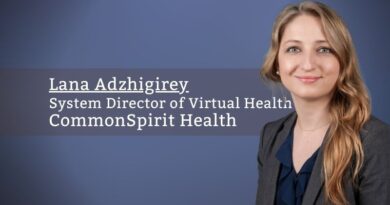COVID-19: Protecting Clinicians and Patients Via Technology and Telemedicine
By Kristin Darby, CIO, Envision Healthcare
We are in a dynamic and transformational time worldwide as we battle the COVID-19 pandemic. Envision Healthcare, one of the nation’s largest facility-based care provider groups, is on the front lines of the crisis and leading the use of technology to protect patients and clinicians. As people adopt social distancing practices and clinicians work around the clock to care for patients, virtual health has become essential in caring for communities throughout the country.
The adoption of virtual health has increased significantly in the past few years. Advancements in technology have made quality care more accessible and, in some cases, more convenient for patients. From primary care visits to teleradiology and telestroke, we’re changing how we deliver the appropriate care at the right time and in the right place.
Now, with nationwide efforts to contain the spread of COVID-19, the adoption of virtual health has been accelerated. Some reports have talked about germ-killing robots, devices that minimize exposure to infected patients, and drones that can quickly transport medicine. However, the real opportunity for impact starts with the technology, and more specifically, the telemedicine capabilities clinicians use to work across and beyond the walls of a hospital to provide care.
We are seeing firsthand how crucial telemedicine is in delivering safe, quality patient care and even in mitigating the spread of the viral infection now and in the future.
Telemedicine reduces the physical interaction between clinicians and patients and supports the preservation of PPE.”
Kristin Darby, CIO, Envision Healthcare
Providing Safe Pre-Hospital Care
During the COVID-19 outbreak, video conferencing is becoming a valuable tool for pre-hospital screening. Pre-coronavirus, when patients thought they were sick, their first inclination was probably to go to the hospital. During this crisis, traveling to the hospital means risking their exposure or putting clinical professionals at risk. Instead of visiting a facility in person and physically interacting with people, telemedicine enables a patient to receive a virtual screening at home.
For example, if patients have been in contact with someone who tested positive for COVID-19 or experiencing symptoms like coughing, shortness of breath and fever, they can schedule a televisit to determine if testing is needed. If testing is recommended, patients are directed to a drive-thru site. They can then return home and self-isolate while waiting for their test results. If patients’ symptoms are life-threatening and require emergency treatment or hospitalization, clinicians can communicate with the appropriate care teams ahead of time so they can prepare to treat the patient.
Envision’s office-based practices have committed time and resources to rapidly stand-up telemedicine. During the first two weeks of operation in late March, we delivered more than 7,000 virtual visits to patients. Patient satisfaction has been high, and many have expressed their appreciation that options are available to reduce their risk of exposure while still receiving quality care.
Reducing Patient and Clinician Exposure through Virtual Rounding
In emergency departments and inpatient units across the nation, clinicians are tapping into technology to round on patients and provide care from a safe distance. Early during the COVID-19 outbreak, we began rapidly deploying telemedicine options for symptom assessment, diagnosis, and treatment in many of our partner hospitals. At the time of writing, we have conducted thousands of virtual medical screening exams and patient monitoring sessions in hospitals, enabling clinicians to safely care for patients when physical contact is not required. Additionally, if providers must be quarantined because of exposure, they have the option to continue delivering care via telemedicine from their homes.
Preserving Essential Personal Protective Equipment and Time
Telemedicine has proven to be an effective way for clinicians to care for and communicate with patients while preserving crucial personal protective equipment (PPE). From gowns, gloves, goggles, masks, and face shields, clinicians must wear the appropriate PPE when caring for patients – especially when a patient has tested positive for COVID-19.
With each patient encounter, clinicians are donning and doffing PPE. This takes time. It also means that in hot spots like New York and New Jersey, clinicians go through PPE quickly. In the midst of a nationwide supply shortage, essential PPE is difficult to source. Telemedicine reduces the physical interaction between clinicians and patients and supports the preservation of PPE.
Enabling Communication among Clinicians, Patients, and Families
Telemedicine tools, such as video-enabled communications, allow for safe and rapid correspondence between clinicians. This can be particularly beneficial in underserved communities, as telemedicine, when used in accordance with the appropriate regulations, enables clinicians to communicate with one another and inform and guide protocols and clinical best practices, which is necessary in a volatile time of crisis.
Due to the contagious nature of COVID-19, it has created an unusual situation in which hospital visitations have been suspended and patients cannot have their family members at their side. During what is a challenging time for patients and their loved ones, we are using multipoint telemedicine sessions to support communication between families, patients, and providers when making care decisions.
COVID-19 has presented many challenges. It has also served as a reminder of how heroic providers are and demonstrated the best in humanity. Clinicians are going above and beyond to provide care and comfort to those in need. They are there when a family member can’t be present. They are traveling to hot spots across the country to provide boots-on-the-ground support. And they are doing it all while putting their health and well-being at risk.
Telemedicine can’t always solve for the physical care a patient needs, such as intubation, nor can it substitute the important rapport that is developed during an in-person visit. But it is helping limit interactions and protect both patients and clinicians during this crisis.
It is the ongoing collaboration, problem-solving, and commitment to caring for one another that will help us get through this pandemic. We have plenty to learn about telemedicine in the wake of a disease outbreak. Once we are on the other side, we will be able to evaluate lessons learned, build upon best practices, and ultimately, continue advancing the delivery of safe, high-quality, patient-centered care.



